The effectiveness of any content marketing strategy depends on how well the content ranks in search engine result pages (SERPs). A higher rank in SERPs ensures your marketing efforts are well-spent. It also helps businesses achieve their desired business goals. However, you can only rank higher in SERPs if you create SEO friendly content. This post is the ultimate beginner’s guide to creating SEO content.
What Is SEO Content?
SEO content, also known as SEO friendly content, is any online content created to rank higher in search engine result pages. It can be a blog post, image, infographic, video, audio, or any other web page. SEO content is optimized for specific keywords, satisfies search intent, and provides the best user experience. In short, it is the type of content, search engines like to rank higher.
Why SEO Content is Important
Businesses create online content intending to reach out to their target audience, generate traffic to their site, and drive sales. However, you can attract organic traffic and leads if your content ranks higher in SERPs.
SEO friendly content enhances online visibility by qualifying to rank for relevant keywords. It also improves user experience by providing comprehensive information that aligns with the search intent. Most importantly, SEO content increases user engagement, positively impacting lead generation.
Steps to Create SEO Content
The following are the eight essential steps to creating SEO content:
Step 1: Choose a topic Relevant to Your Audience
The first step towards creating SEO content is choosing a topic for your content. The topic should be relevant to your niche and target audience. It should cover the subject matter your audience would like to read. Select a topic that addresses your target audience’s needs, concerns, problems, and demands.
However, to understand your target audience’s interests, you must define who they are. Researching an existing audience base helps define your target audience and discover their interests, likes, dislikes, demands, problems, etc. Look for information like age, gender, location, and language to create an ideal customer persona.
After defining your target audience, you can conduct surveys to learn about their problems and interests. The results of those surveys can be a gold mine of content ideas.
The following are a few other ways to generate ideas for topics:
Analyze Competitor Blogs
Your competitors target the same audience, making their top-performing blog posts ideal for generating SEO friendly content ideas. Look for posts that:
- Have excessive backlinks.
- Are often shared on social media.
- Generate plenty of organic traffic.
Manually analyzing competitor blog posts can be tiring and exhausting. Therefore, I recommend using tools like SEMrush, Serpstat, and SpyFu.
For example, in SEMrush Orgnaic Research Tool, if you enter the competitor domain name and choose the target location, you will get a complete list of competitor’s keywords. Additionally, for each keyword, you will learn how much traffic they generate and where they rank in SERPs.

Read Blog Comments
Read comments on your blog posts to learn about your audiences’ thoughts. They may have questions or add valuable information, which can be an excellent source for exciting content ideas.
Post a Poll or Question on Social Media
If you are already present on social media platforms, you can post a poll or question to learn about the topics your audience wants you to cover. For diverse options, you should post a question, while to learn about audiences’ views on a list of options, you should create a poll.
Check Q&A Forums
Another effective method of discovering SEO friendly content ideas is to check questions your target audience asks on Q&A forums, such as Quora and Reddit. BuzzSumo is a popular tool content creators use to find top-performing content on platforms like Reddit, Twitter, Facebook, Pinterest, and YouTube.

Step 2: Research Primary and Secondary Keywords
Now that you have a list of topics, it is time to research primary and secondary keywords to target in your SEO content.
Keyword research is a critical step for creating SEO content. You will not rank in SERPs if you do not target the right keywords in your content.
When researching the keywords, consider the following two metrics:
Search Volume: Search volume indicates the average number of times online searchers type the keyword in the Google search seeking information. Keywords with high search volume generate plenty of traffic but are difficult to rank for. Similarly, low search volume keywords are relatively easier to rank for but generate less organic traffic.
Search Difficulty: Search difficulty is a measure that indicates how difficult it is for a keyword to rank in Google search results. A high search difficulty means the keyword is highly competitive, while a low search difficulty indicates it is easy to rank in SERPs.
To find search volume and difficulty, you can use popular keyword research tools like SEMrush, Serpstat, and SpyFu. Below is the screenshot of the keyword overview in SEMrush.
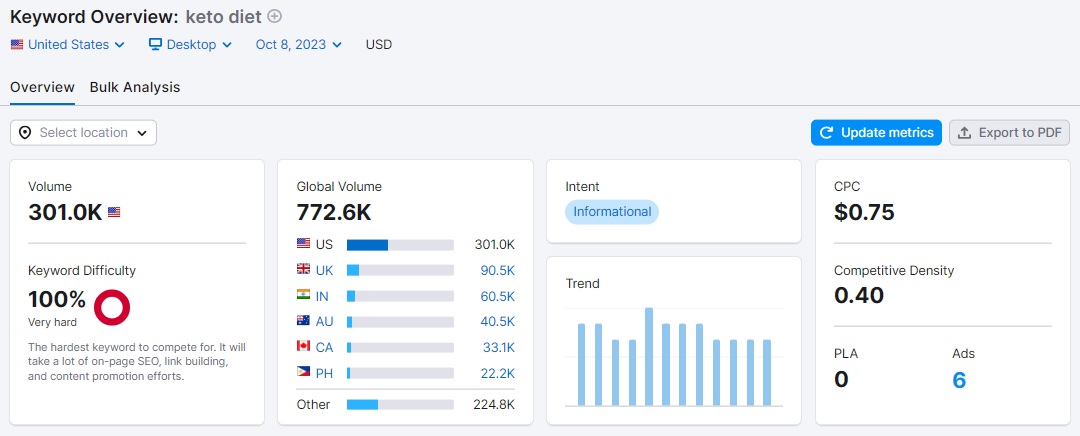
SEO content targets keywords that are easy to rank for and have reasonable search volume.
Primary Keyword
Two popular primary keyword search methods are Google Search autocomplete and keyword research tools.
In Google search, if you type the topic, Google will show a list of suggestions for autocomplete. For example, typing the keyword ‘keto diet’ in the Google search bar gives the following autocomplete suggestions.
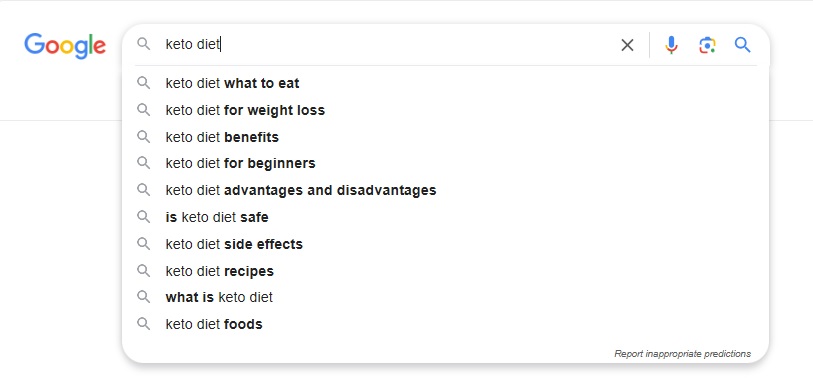
These suggestions are based on actual search keywords people use to find information. Therefore, they are ideal for the primary keyword.
Alternatively, you can rely on keyword research tools for an exhaustive list of keyword ideas. Below are the ‘keto diet’ results in SEMrush Keyword Magic Tool.
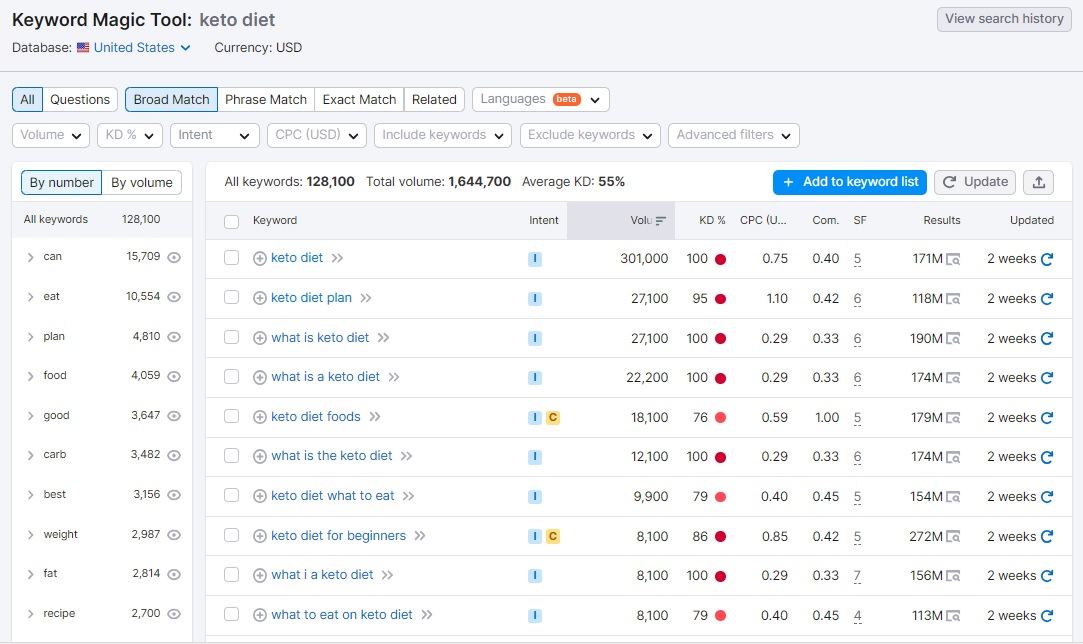
Secondary Keywords
Secondary keywords are the subtopics you will target in your SEO friendly content. They are primarily long-tail versions of the primary keyword.
Like primary keywords, you can get suggestions for secondary keywords from both Google and keyword research tools.
For every search, Google displays a section, ‘People also ask’. In this section, Google shows popular questions people ask about the search term.
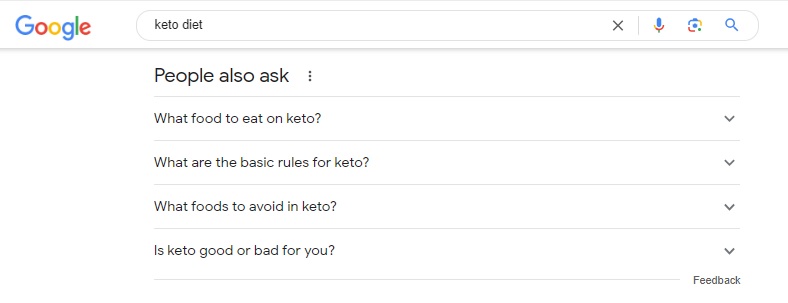
These questions are ideal suggestions for secondary keywords.
If you click on any of the questions, the list of suggestions will grow. In other words, you can use this section to get a long list of recommendations for subtopics to be included in your SEO content.
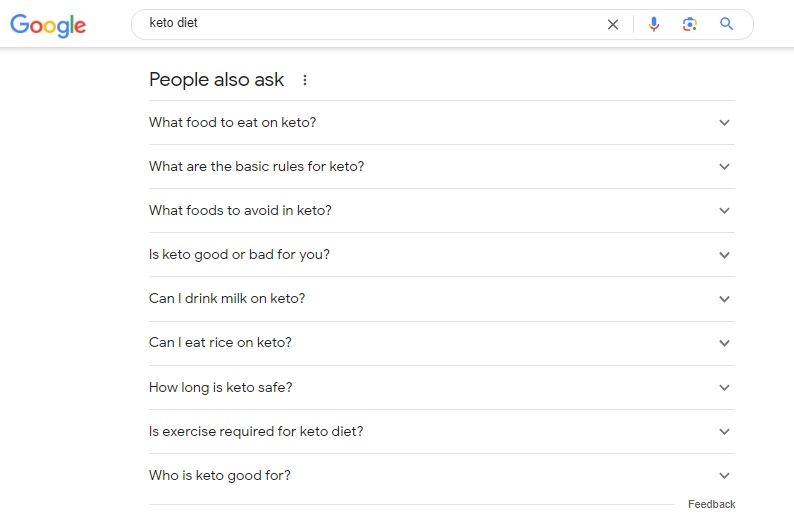
Keyword research tools like SEMrush are more effective in finding secondary keywords as they give valuable information such as search volume and difficulty along with keyword suggestions.
For example, in SEMrush Keyword Magic Tool, if you filter the keyword suggestions to show only questions, these are the subtopic ideas you can include in your SEO content.
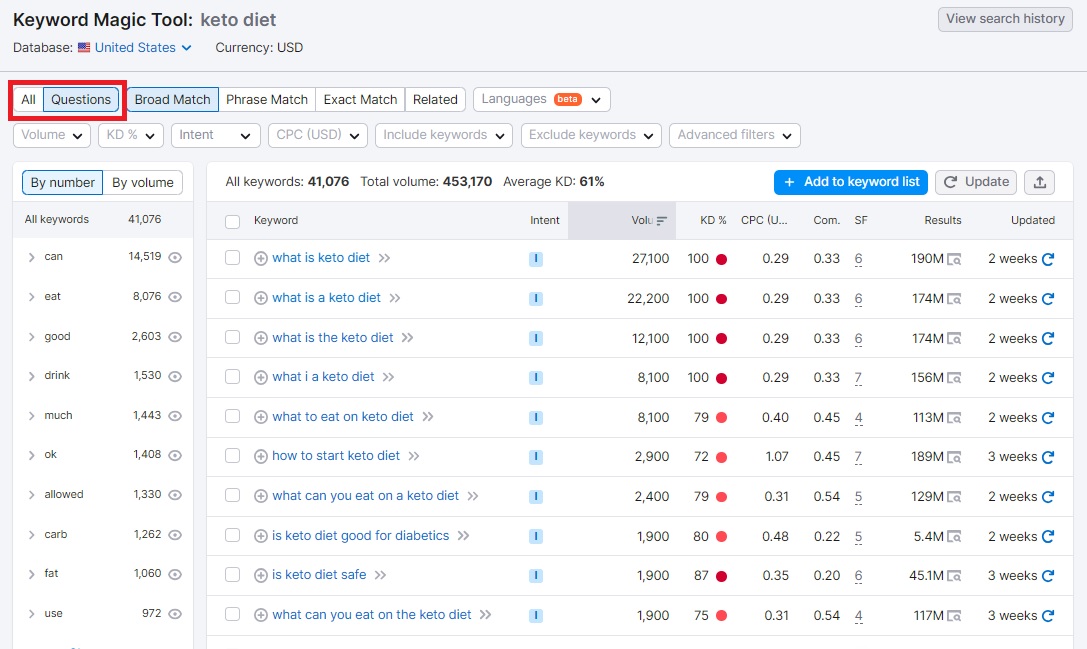
Step 3: Determine Search Intent
It is critical to determine the search intent before you write a single word for SEO friendly content.
Search intent is the goal the user is trying to accomplish by conducting an online search. Google values search intent and returns only relevant content in response to a search query. Its algorithm learns search intent for every keyword searchers use to find information and strives to display only those web pages that match the intent.
SEO content matches the search intent and fulfills the requirements of the searchers. Therefore, before you start writing content, you should find out what the searchers expect when they use a specific keyword for searching online.
The following are the four major intent types:
Information Intent: A keyword has informational intent if the user seeks answers or information. Keywords with informational intent include words like ‘what’, ‘how’, ‘why’, ‘guide’, etc. The content types that satisfy informational intent include tutorials, how-to guides, and why posts.
Commercial Intent: A keyword has commercial intent if the user wants to explore or consider available options before making a purchase decision. Keywords with commercial intent include words like ‘best’, ‘top’, ‘review’, and ‘comparison’. The content types that align with commercial intent include list posts, reviews, and comparison posts.
Transactional Intent: Transaction intent means the user is ready to complete an action such as purchase, registration, or download. Keywords with transactional intent include words like ‘buy’, ‘download’, ‘cheap’, ‘discount’, etc. Content types that match transactional intent comprise product, registration, or sign-up pages.
Navigational Intent: Navigational intent means the searcher intends to visit a specific page or website. Keywords with navigational intent include brand, business, or product name. Home or landing pages are content types that align with navigational intent.
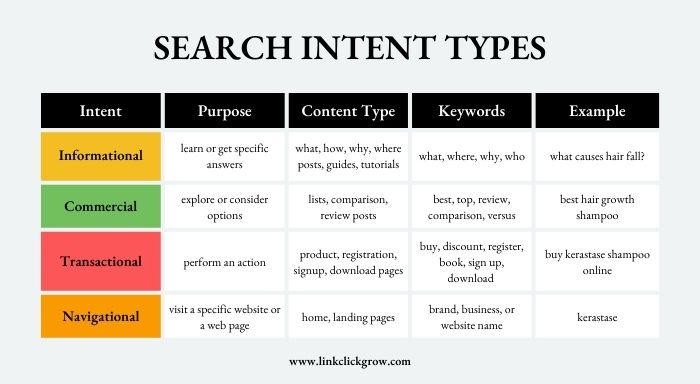
Mostly, the search intent is evident from the words in the keyword. But sometimes, the keyword intent may be different from what you think. For example, if you search ‘plagiarism checker’ in Google, you will get the following results:
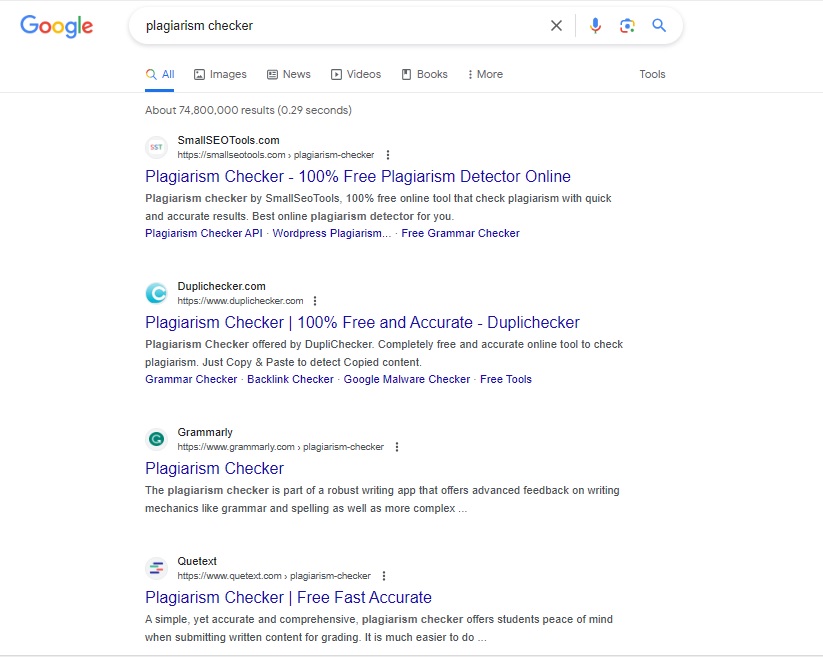
As you can see, the results are product pages, not blog posts. It means the users intend to buy a plagiarism checking tool rather than looking for information about how plagiarism checkers work.
Remember, SEO friendly content is more than just the right content type. You must analyze the top-performing pages to determine what kind of information they have included. The average content length, the common sub topics, and the approach of each content can help you understand what Google and users expect in your content.
To create SEO content, address the topics covered in top-ranking pages and include additional information that your competitors have missed.
Step 4: Write Comprehensive Content
Search engines aim to provide the highest quality content to their users for the best experience. They prefer quality content when ranking web pages in SERPs. Therefore, SEO content covers the topic in-depth, providing all the relevant details the user might need.
Research the topic well and write comprehensive content. Comprehensive content is beneficial for the following reasons:
- People spend more time reading long-form content, increasing the average time spent on web pages.
- Comprehensive content ensures you have answered all the questions the user might have concerning the topic.
- Google better understands the context of the web page. As a result, relevance to the search intent is established.
- Long-form content tends to perform better in SERPs.
- Long-form content gets more likes and is more frequently shared on social media.
- Comprehensive content qualifies for additional keywords, enhancing your ranking opportunities.
Remember to include additional information your competitors have missed in their content. It would give you a competitive advantage.
Step 5: Make Content User Friendly
Google considers user experience signals when determining the rank of a webpage. User experience signals include bounce rate and average time spent on a page. Therefore, SEO friendly content is easy to read and consume.
To ensure your SEO content is user friendly, consider the following best practices:
Structure Content into Headings
Headings make content easy to read and consume. They make it easy for the users to scan the page and find the necessary information.
Besides user experience, headings help search engines better understand the context of your content. It becomes straightforward for the search engines to find the right keywords, increasing your chances of ranking for those keywords.
Use Short Paragraphs and Sentences
Short paragraphs and sentences are easy to understand. On the contrary, long paragraphs and sentences can frustrate the users, who may lose interest in your content. Ideally, you should include at most five sentences in a paragraph, while each sentence should contain no more than 25 words.
Use Multimedia
Using multimedia ensures you are catering to all kinds of audiences. People have varying preferences when it comes to consuming information. Therefore, include audio, videos, images, infographics, and text to provide the best user experience.
Proofread Content
Always proofread the content to ensure there are no grammatical or spelling mistakes. Grammarly, ProWritingAid, and WhiteSmoke are popular grammar-checking tools you can use to review your content and find errors.
Step 6: Optimize Your Content for Keyword
It is the most critical step in creating SEO content.
Strategically Include Keywords
Gone are the days when you would stuff keywords in your content to rank in SERPs. Now, search engine algorithms have become more intelligent. They use not only the keywords but also the associated phrases to understand the context of the content.
To make your content SEO friendly, use keywords strategically. They must appear naturally in your content. Additionally, use them only and where they add value to the content.
Use LSI (latent semantic indexing) keywords to avoid keyword stuffing and establish relevance. LSI keywords refer to keywords that are semantically associated with the primary keyword. They assist search engines in understanding the context of your content, thus helping your content rank higher in SERPs. To determine LSI keywords, I recommend using tools like LSIGraph.
Include Primary Keyword in Meta Description, URL, Title, and H2
Besides using primary keyword in your SEO content, you should include it in your Meta description, URL, title, and H2 headings. Including focus keywords in these places ensures search engines better understand your content. As a result, you rank higher in SERPs for the keyword.
Additionally, keyword optimized Meta descriptions and title tags increase click-through rate. They appear in SERP listing and help establish relevance to the searchers.
Add Internal Links
SEO friendly content includes not only external links but also internal links. Internal links are beneficial for SEO for the following reasons:
- Like backlinks, internal links pass page authority from one page to another. Linking from a high authority page to a low authority page helps the latter rank higher in SERPs.
- Internal links direct users to other relevant content on your website. As a result, the bounce rate decreases, and the average time spent on web pages increases.
- Internal links make crawling efficient. Since each website has a limited budget, internal links help search engines understand the site’s structure, leading to efficient crawling.
- Internal links make it easy for the search engines to find new pages. New content might take longer to index and rank in Google without internal links.
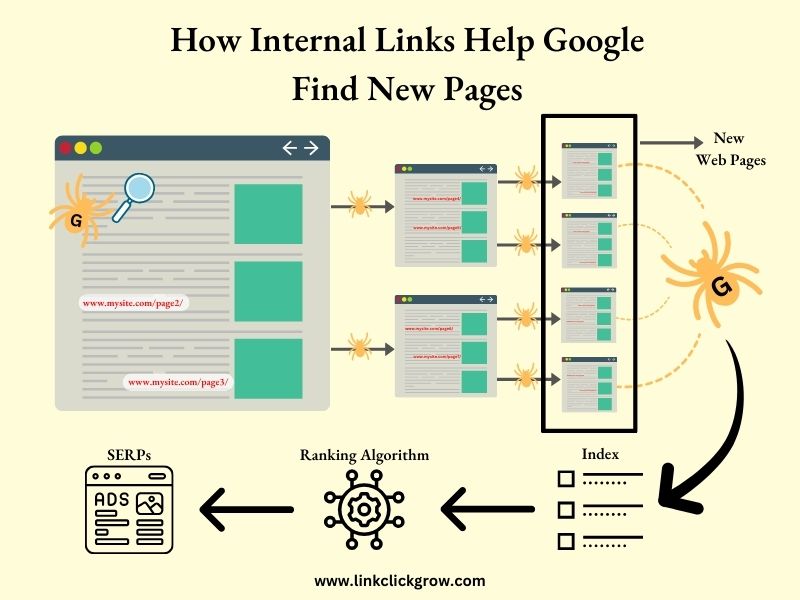
However, for the anchor text, you should follow the following best practices:
- Keep it short.
- It should reflect the content of the linking page.
- Do not use generic words or phrases like ‘click here’, ‘find here’, etc.
- Do not use the same anchor text over and over again. Instead, use variations.
Adding internal links can become complex and time consuming as your website grows. I recommend using tools like LinkWhisper, RankMath, and Internal Link Juicer for efficient internal link building.
Step 7: Make Content Mobile Friendly
Most searchers use mobile phones to search for information online, which is why Google uses mobile versions of sites for indexing and ranking. Therefore, making your content mobile-friendly is critical to ranking higher on SERPs.
In short, SEO content is mobile responsive.
The following are a few best practices for making content mobile-friendly:
- Write short titles to keep it from being truncated in SERP listing on mobile screens. Short titles have a high click-through rate in comparison to long titles. Ideally, a title should contain at most six words.
- Highlight information with the help of bullets, lists, tables, and diagrams.
- Replace wordy phrases with one-word substitutes. For example, a single word substitute for the phrase ‘a majority of’ is ‘most’.
- Replace complex words with synonyms. For example, a simple alternative for the word ‘utilize’ is ‘use’.
- Use enough white spaces for better focus and readability.
Step 8: Build Backlinks
SEO friendly content has plenty of backlinks, making it ideal for ranking higher in SERPs.
To date, backlinks are among the top ranking factors. Search engines consider backlinks or incoming links as a vote of confidence in your content. As a result, they reward your web page with a higher rank in SERPs.
Although it takes time to build authority links, creating quality content can expedite the process. Besides creating quality content, you should use link-building strategies to earn valuable backlinks.
Conclusion
Creating SEO content is critical for the success of any content marketing strategy. However, it may take a few months to see the results despite following the abovementioned steps. Nonetheless, analyze your performance regularly to assess what works for you and what you need to do more. Lastly, remember making older content SEO friendly is equally essential for better rankings.

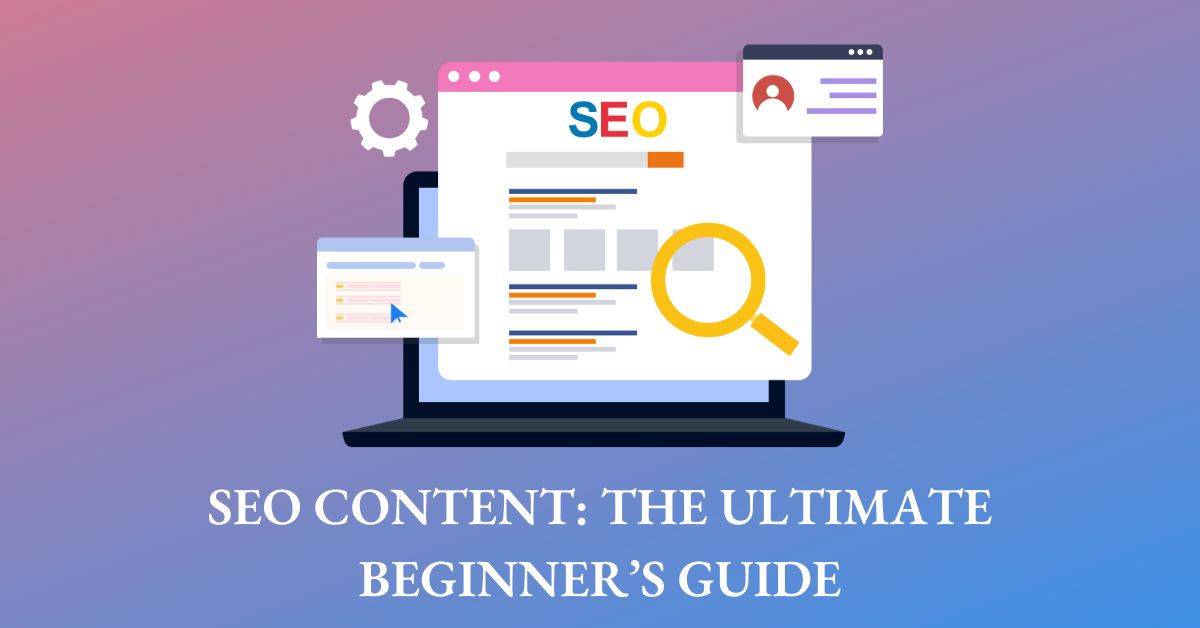
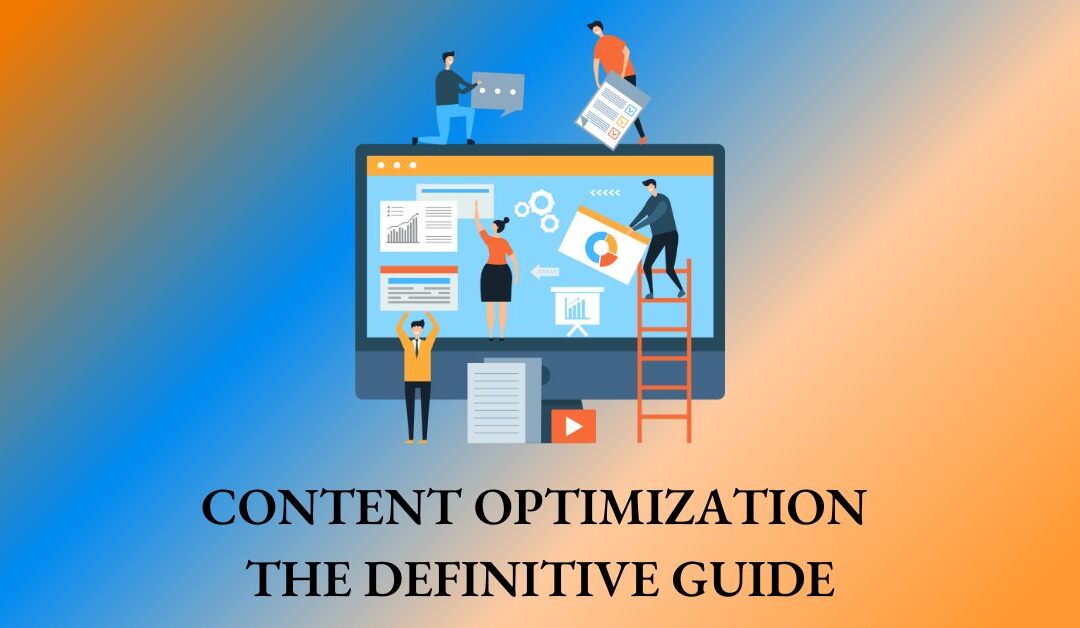
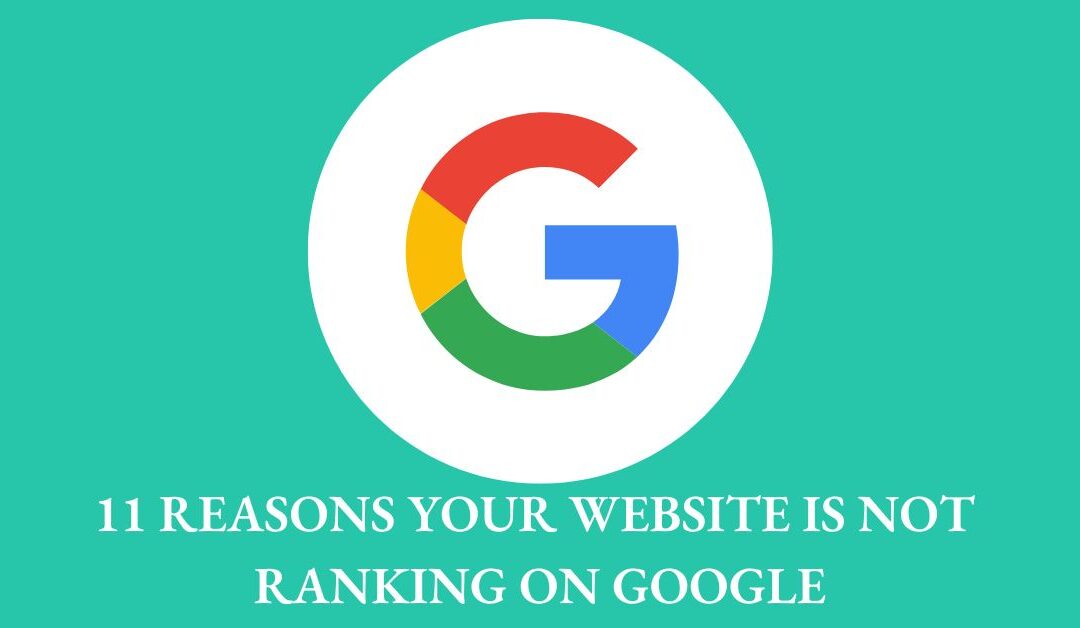


0 Comments